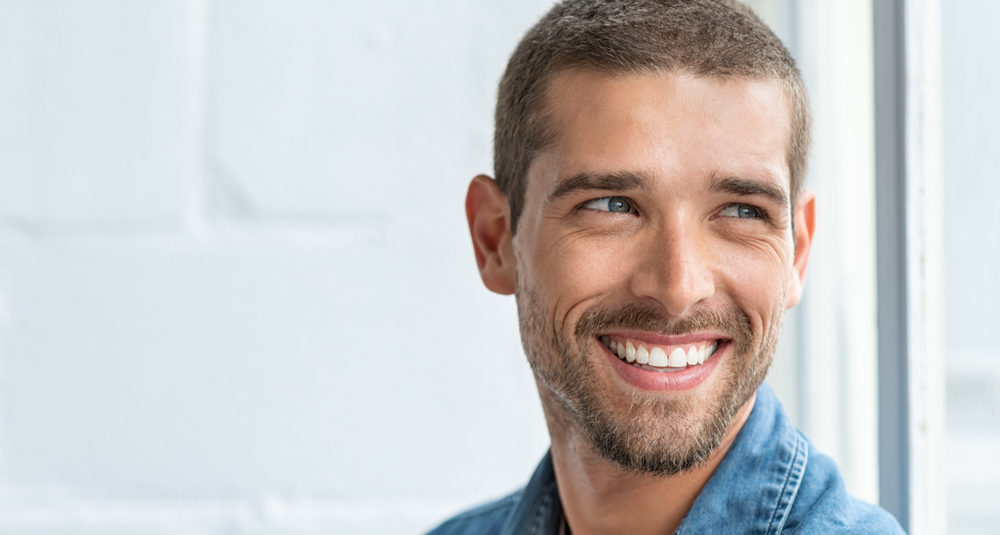Looking to straighten your teeth and improve your smile discreetly and effectively? Clear aligners might be the treatment option for you. As an alternative to traditional braces, clear aligners are nearly invisible and yield fantastic results. So if you’re thinking about Invisalign® or braces, here’s what you need to know about clear aligners to help you decide. In this post, we’ll answer:
- What is clear aligner therapy?
- How do clear aligners work to straighten teeth?
- Do clear aligners fix misalignment and what causes gaps in teeth?
- What does the clear aligners procedure look like?
- What clear aligner options are available at VanderWall Orthodontics?
- How to keep my teeth straight after treatment?
What is clear aligner therapy?
Clear aligner therapy is an alternative to braces for achieving a functional, straighter smile. Unlike braces — that are attached to your teeth for the entirety of your treatment — clear aligners are removable, BPA-free, clear plastic trays that fit over your teeth. You wear them for 22 hours a day and take them out to eat, when you drink anything other than water, and when you brush and floss your teeth.
With clear aligner treatment — whether it’s the well-known Invisalign® orthodontic aligners or an Invisalign® alternative like 3M™ Clarity™ Aligners — you use a series of custom made plastic trays that you swap out throughout your treatment. Treatment is typically a progression of 18-30 sets of aligners, depending on your alignment needs. From the first set to the last, each set is designed to align your teeth step-by-step into their final positions.
Many of our patients choose clear aligners like Invisalign® over braces because clear aligners offer minimal interference into day-to-day life. They have perks like:
- You can eat and drink as usual. You don’t have to avoid certain foods that might damage your appliance like you do with braces.
- They’re nearly invisible so you get fantastic results without looking like you’re going through orthodontic treatment.
- They’re comfortable. Instead of experiencing periodic discomfort when tightening or adjusting your braces, you instead enjoy a gentle, continuous pressure throughout your treatment time. Clear aligners are also trimmed to the gums so there’s nothing rubbing against them.
- They’re a time saver! No adjustments means shorter check-ins with Dr. VanderWall. Plus, they won’t break so it’s less likely you’ll have delays due to an appliance that needs repair.
- No awkward flossing around braces wires or more diligent cleaning required. However, you do have to take a few minutes everyday to gently clean and rinse your aligners.
How do clear aligners work to straighten teeth?
Now that you’ve got the basic idea, are you wondering how clear aligners actually straighten your teeth? Do they work like braces? What’s the difference between clear aligner treatment like Invisalign® vs. braces? Well, the science behind clear aligners is fairly straightforward:
All clear aligners use a pushing motion that activates the periodontal ligaments connecting each tooth’s roots to its socket. This pushing force stretches the ligaments on one side of the root, and as a result, compresses the ligaments on the other side of the tooth root. This stretched ligament/compressed ligament event signals osteoblasts to build new bone cells on the stretched side, while osteoclasts break down bone cells on the compressed side. This allows a tooth to slowly shift. At the end of your clear aligner treatment when each tooth is in its final spot, the ligaments will need time to adjust and your tooth roots time to settle securely into their socket.
Do clear aligners fix misalignment and what causes gaps in teeth?
When comparing Invisalign® vs. braces, it’s understandable that you might be hesitant about using clear aligners. Maybe you’re even thinking, “Can I even get Invisalign®?” After all, clear aligners are a newer orthodontic treatment than braces and many people aren’t as familiar with them. However, in the hands of an experienced provider like Dr. Clay VanderWall, Invisalign® and Clarity™ Aligners are on par with braces for addressing most misalignment issues. You might even say they have a leg up on braces because they’re more discreet than your traditional metal braces and more convenient too.
So what issues does Invisalign® treat? Clear aligners like Invisalign® are great for underbites, overbites, crooked, and crowding teeth. Clear aligners can even fix what causes gaps in teeth — small spaces like diastema — or help align teeth that surround a larger gap so that the space becomes the right size for a dental implant or bridge.
What does the clear aligner procedure look like?
- Consultation with Dr. VanderWall
First, visit our Durham, Cary or Raleigh, NC office for your free initial consultation. At this appointment, we’ll take complementary digital x-rays and Dr. VanderWall will examine your teeth to see if Invisalign® orthdodontic aligners or Clarity™ Aligners are right for you. And we’ll talk about your treatment options and answer all your questions. Next, one of our friendly team members will go over financial things — how much Invisalign® costs and your Invisalign® cost with insurance. We can also discuss in-house financing options. If you’re ready to decide on clear aligner treatment at this point, we can usually continue on to the next step right away.
- Digital, 3D Imaging of Your Mouth
Step two is diagnostics. At VanderWall Orthodontics, we use innovative, cutting edge technology so that our patients can enjoy efficient, precise, and comfortable service. For clear aligner treatment, we use the iTero® digital scanner to take quick and painless digital impressions of your teeth. These images are sent to our computer, which creates a digital, 3D rendering of your mouth. Dr. VanderWall then plans out every step of your clear aligner treatment on the 3D model, which means you can see how and when your teeth will move from beginning to end, even before starting treatment.
- Pick Up Your Clear Custom Clear Aligners
Dr. VanderWall then sends your prescription to the Invisalign® or 3M lab. They print your custom set of aligners which you’ll pick up at our office. Now you’re ready to start your Clarity™ Aligners or Invisalign® teeth treatment!
- Wear Your Aligners 22/7
Having Invisalign® teeth or Clarity™ Aligners means wearing them 22 hours every day. As mentioned previously, you only take them out when you eat, when drinking anything other than water, and when cleaning your teeth. It’s important to wear your clear aligners for most of every day so you can stay on-track with your treatment plan. Throughout treatment, you’ll switch aligners every 1-2 weeks.
And if you’re wondering if clear aligners need adjusting like braces do, they definitely don’t! But you’ll still visit us every 6-8 weeks so Dr. VanderWall can check on your progress and make sure you’re still on-track.
- Show off that New Smile!
After your last set of aligners, you’re ready to face the world with a brand new smile and a healthy bite! Come in to one of our NC offices for one more set of digital impressions so that we can create a custom retainer to lock your new teeth positions into place. A retainer? Yes, wearing a retainer after Invisalign® or braces is typical. Retainers help your teeth settle into their new positions after all the hard work they’ve done!
At first, you’ll wear your retainer 24/7, but after a prescribed amount of time, you’ll only need to wear your retainer at night. Wearing a retainer ensures your results will last a lifetime!

What clear aligner options are available at VanderWall Orthodontics?
We have many orthodontic treatment options at VanderWall Orthodontics, but you might have already guessed that when it comes to clear aligners, we offer Invisalign®/Invisalign® Teen orthodontic aligner and 3M™ Clarity™ Aligners.
Invisalign®/Invisalign® Teen:
It’s safe to say that Invisalign® is the most well-known clear aligner treatment. Pair that with the fact that Dr. VanderWall is a leading Cary, Raleigh, and Durham Invisalign® provider and you can be confident that your results will be amazing. Dr. VanderWall has experience treating a wide range of orthodontic cases with clear aligners, both simple and more complex.
If you have a pre-teen or teen interested in clear aligner treatment, Invisalign® Teen aligners are exactly like regular Invisalign® — they just have additional tabs at the back to accommodate erupting molars. Plus, you get a few free replacement aligners in case your child misplaces a few sets in the busyness of their daily activities!
3M™ Clarity™ Aligners:
This brand of aligners work just like Invisalign® and can treat a wide variety of issues, from crowding to gapping to overbites. 3M™ Clarity™ Aligners can be used in concert with braces if your orthodontic issues require it.
How do I keep my teeth straight after treatment?
Like we mentioned earlier, you’ll want to lock in your results after treatment so you can enjoy them for life. How? A custom-designed retainer is the first step in how to keep your teeth straight! For the first few months, you’ll wear your retainer all the time, but before you know it, you’ll transition into wearing it only at night (if it’s a removable one). Wearing and caring for a retainer is typical after most teeth-straightening treatments, whether you opt for clear aligners, traditional or invisible braces.
At VanderWall Orthodontics, we offer three types of retainers: the Essix retainer, the Hawley retainer, and the bonded retainer. Dr. VanderWall will suggest the best one for how to keep your teeth straight once he’s examined your new smile.
Essix Retainer – A clear, plastic retainer, this one is removable and fits over the entire arch of your teeth. It’s the retainer that most likely comes to mind since they’re the most popular.
Hawley retainer – This retainer is made up of both acrylic and wire. Like an Essix retainer, a Hawley retainer is removable. The acrylic part fits up against your palate, while the wire wraps around your teeth to keep them in their new positions. For patients who want a bit of flair, we can personalize the acrylic — it comes in different colors and patterns.
Bonded retainer – Attached to the backside of your teeth, a bonded retainer is a wire that is permanently attached. It’s usually placed on the bottom teeth, but can be affixed to your top teeth if needed, and they’re nearly invisible. However, you do have to pay special attention to them when cleaning your teeth — making sure to floss well between the wire and your teeth and brush thoroughly.
A few other tips for how to keep your teeth straight after clear aligners? Make sure you continue seeing an expert orthodontist. As a board-certified orthodontist, you can be sure that Dr. VanderWall knows how to help you maintain your new dream smile. Second, avoid quick fixes — you succeeded in making it through orthodontic treatment, so make sure any future treatments are just as trustworthy and effective.
We’re Here To Help You Transform Your Smile with Clear Aligners
With all this information about clear aligners, we hope you’re well-informed about the Invisalign® process and excited about taking first steps in getting a confident, healthy new smile. As a leading provider of Invisalign®, Dr. VanderWall is an expert in using Invisalign® for an underbite, overbite, crooked and crowding teeth amongst other concerns.
Contact us today to set up your complimentary initial appointment at our friendly Raleigh, Durham, or Cary office.



